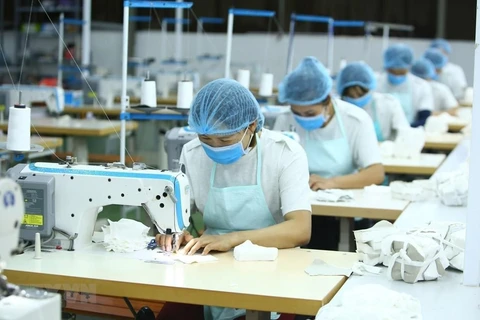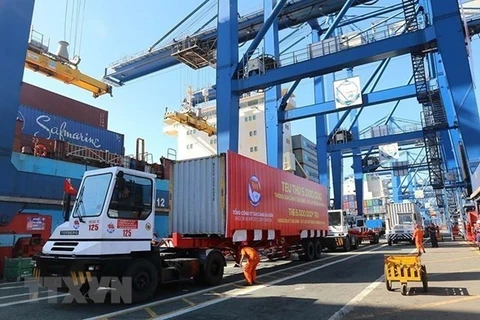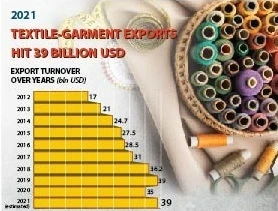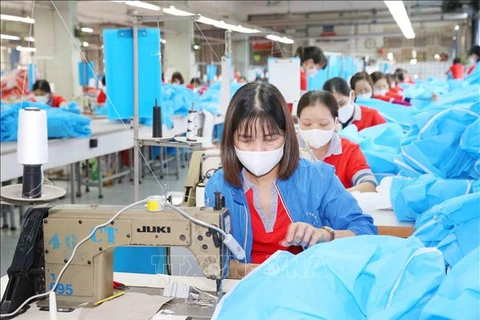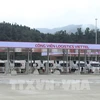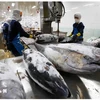Hanoi (VNA) – Overcoming a series of difficulties caused by the COVID-19 pandemic, the garment and textile industry is now employing some 2.5 million workers, while generating 40 billion USD worth of export and a trade surplus of nearly 20 billion USD.
Last year, the sector began recovering as its key major markets bounced back thanks to effective economic stimulation packages, said Executive Director of the Vietnam Textile and Garment Group (Vinatex) Cao Huu Hieu, in an interview with the e-newspaper VietnamPlus.
Hieu listed a series of difficulties and challenges facing garment-textile firms over the past two years, such as decreasing demand and disrupted material supply that led to the cancellation or postponement of orders. Distancing measures at home also caused domestic revenue to plunge, he said, adding that they had to manage to avoid being fined due contract violations due to social distancing, to keep old customers and ensure social security for workers.
The executive director advised the sector work to complete production stages, develop material sources, particularly yarn and fabric, and prepare necessary human resources, especially those that help the industry engage in higher value-added stages in the supply chain like designing, marketing and distribution.
During the interview, Hieu also talked about Vinatex’s workforce crisis when the pandemic directly hit industrial parks. He said when the disease spread in the south last year and within a month the company saw 40,000 staff, mostly in the region, unable to work.
According to him, in response, the group had decided to sustain its human resources. The specific direction had been issued and plans for production during the time of outbreaks had been built.
 Cao Huu Hieu, Executive Director of Vietnam Textile and Garment Group (Vinatex) (Photo: VietnamPlus)
Cao Huu Hieu, Executive Director of Vietnam Textile and Garment Group (Vinatex) (Photo: VietnamPlus) Vinatex leaders appeared in video clips to explain the group’s policy and encourage people to work, while support was given to workers contracting COVID-19 or interacting with infected people. As a result, the rate of absenteeism in the first six months of 2021 was over 30 percent lower than the average of other years.
Vinatex also paid attention to accelerating vaccination against COVID-19 for workers, with 100 percent of its labourers in Hanoi and Ho Chi Minh City having received two full shots so far.
When the situation got better, the rate of Vinatex workers returning to work now was close to 90 percent.
Such a difficult period highlights the need for digital transformation. Hieu said the sector plans to focus on smart industry and technological applications for production and business automation. However, such progress will replace a certain number of the workforce and raise questions about solutions to handle situations arising in terms of labour redundancy and social security in labour-intensive industries such as garment-textile.
With its export targets toward 2030, the industry is capable of generating between 250,000 and 300,000 new jobs per year. In addition to the occupations that are replaced by automation equipment, the sector plans to set up new positions such as fashion designers, marketing staff and maintenance technicians.
However, textile workers are characterised by relatively low qualifications, with 84.4 percent of them only completing general education. The number of workers with intermediate or higher qualifications accounts for only 15.6 percent of the workforce.
Therefore, Hieu noted the focus should be given to improving training with qualifications and skills, especially knowledge related to information technology, automation and design.
He stressed that if the sector invests in technology to build a reasonable production management system and improve labour productivity, its labour price per product will be reduced, while labour wages will increase.
This also helps to solve the problem of labour shortage, creating an opportunity for Vietnam's textile and garment industry to break through and get out of the trend of using a lot of labour but with low and unstable wages, he said./.

